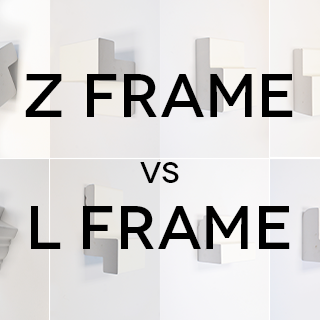There are a number of things to take into account when deciding on an L-frame or Z-frame for mounting your shutters. Let’s start with a few questions that need to be answered in order to make the best design decision for your shutters:
- Do I prefer the look of an L-frame or a Z-Frame?
- Do I want the shutters to project into the room (outside mount) or be recessed into the window (inside mount)?
- Do I have tilt in windows?

In order to answer these questions we must first understand why a shutter needs a frame. Simply put, most windows do not have a completely square opening, which is needed to install square shutters (or 100% symmetric shapes if you are installing say an eyebrow shaped shutter). The solution is to build a frame designed to fit the specifications of your window that will also create a square opening with which to support your new shutters. The shutter panels will then be hinged to the frame, completing the look and supporting the functionality of the shutter.
We now need to understand the difference between the frame types. First there is the L-Frame. As the name suggests, the frame looks like the letter L. You may use an L-Frame as an inside or outside mount. Inside mount L frames are discouraged when a window is more than ¼ inch out of square, or had tilt in functionality. This is because the L-frame does not have any additional projection that can cover up the inconsistencies of the window. So if a window is out of square, you will have to make up for the inconsistencies by caulking around the shutter. Caulk lines that are more than ¼” thick are not appealing and most consumers will not be happy with heavy caulking around their shutters. If the window is more than ¼” out of square, you can still use an L-frame as an outside mount. When mounted outside of the window, the L-frame can cover up all of the inconsistencies, but it will project into the room creating a boxier look than an inside mount frame.
If you do not care for the look of an L-frame, you may also use a Z-frame. Much like an L-frame, the Z-frame gets its name because it is shaped like the letter Z. Z-frames are used for inside mounts only. Part of the Z sits inside the window, while the other part creates a lip around the window. This ensures a clean frame around your window, and will cover up any out-of-square inconsistencies. Since Z-frames will always have a part of the frame on the inside of the window, they will disrupt the use of your tilt in windows, and are therefore not recommended for tilt windows. If you have tilt in windows and you would like to retain the tilt in feature, you cannot use a Z-frame for your shutters.
Once you have decided on a style that works for you, and have checked to make sure that the frame that you have selected will work with your windows, you will be free to enjoy the pleasure of your new shutters.







